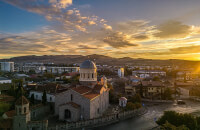



Discover the ancient cave city of Uplistsikhe - “Fortress of God” and Borjomi National Park!
City of Gori. One of the main attractions of Gori is the complex of the State Museum of J.V. Stalin.
In the very center of the city, against the backdrop of old buildings, a huge palace in the original Gothic style stands out as a bright spot. This is the Stalin House Museum, built in the 50s of the last century. The museum was built next to the house in which on December 21, 1879. The great J.V. Stalin was born into the family of shoemaker Vissarion Dzhugashvili. The Stalin Museum is dedicated to all aspects of the life of the famous leader. It has three departments displaying rare exhibits: original letters and notes, photographs, military chronicles, maps, battle diagrams, Stalin’s personal belongings, photographs of the sons Yakov and Vasily, letters, the generalissimo’s uniform, and a death mask. The museum also stores the archives of the leader, including poems for children and youth. Gifts to Stalin are collected in a separate room. Everywhere – Busts of Stalin made of stone, wood, plaster. A special exhibit – Stalin's personal armored comfortable carriage with a luxurious interior for that time: Venetian glass mirrors, carved furniture.
The carriage was installed next to the museum relatively recently – transferred to the North Caucasus Railway in 1985. The carriage has been preserved almost in the same form in which Stalin used it during his trips to the Yalta and Tehran conferences. Nothing was altered or restored inside the carriage. Everything is as it was during Stalin’s life: an office with a table, a telephone and a sofa, a bathroom, a security compartment.
Borjomi Park has become the hallmark of Georgia thanks to its amazing mineral water. Its healing properties were known back in ancient times. It is important to note that this water is of volcanic origin. It is pushed to the earth's surface by natural carbon dioxide from a depth of about 8-10 kilometers. The uniqueness of Borjomi is that, unlike many other mineral waters, it does not have time to cool underground, so it comes out warm, enriching itself during its journey with many minerals contained in the Caucasus Mountains. Borjomi Park was officially called a nature reserve only in 1935. However, attention was first drawn to the extraordinary beauty of these places back in the Middle Ages. The unique power of water and natural beauty attracted the aristocracy here. A small town quickly grew up in the gorge near natural springs. Members of the Imperial House of the Russian Empire also came to relax in Borjomi, improve their health and breathe the purest mountain air. Later, during the reign of the Russian Emperor Alexander II, his brother Prince Mikhail, who was the governor of the Transcaucasian region, built himself a summer house there for relaxation and work in the lap of nature. And a little later he completely fenced off most of the land, prohibiting hunting without special highest permission. Already in the 20th century after the declaration of independence of Georgia, in 1995, the Borjomi-Kharagauli National Park was created on the basis of the reserve, the official opening of which took place only six years later, in 2001
Languages of the tour
- Russian
- English
Route
- City of Gori
- Uplistsikhe city in the rock
- Borjomi Park - mineral springs
Information
Choose comfortable shoes and clothes for the tour.
Take a headscarf for visiting the temple.
Free cancellation 72 hours before the start of the tour.
Attractions

Borjomi is a magical corner in the heart of Georgia, famous for its healing mineral springs. Here you will find not only transparent waterfalls and picturesque gorges, but also historical monuments. The city amazes with its atmosphere of calm and tranquility, especially in the park where the royal family spent their holidays. Borjomi is not only history and nature, but also water, which gives this place a special magic.

Uplistsikhe is an ancient cave city in Georgia. It was one of the country's first cities and included more than 700 cave structures, although only about 150 remain today. This amazing complex offers a unique insight into the architectural development and history of Georgia, and its labyrinth of caves, temples and residential areas are still the day inspires you to study the history, myths and legends of this place.

Gori is one of the oldest cities in Georgia. Gori received official city status in 1801. The city takes its name from the rock formation (goraki) in the center of the city, on which the remains of the ancient Goristsikhe fortress are located.
In the very center of the city, against the backdrop of old buildings, a huge palace in the original Gothic style stands out as a bright spot. This is the Stalin House Museum, built in the 50s of the last century.




